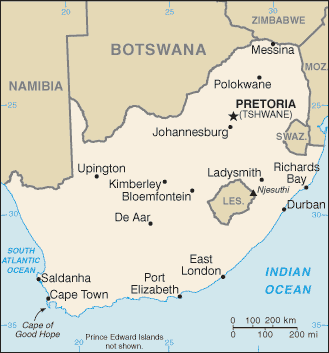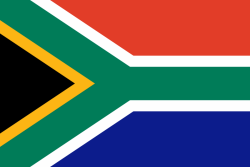Republic of South Africa
Related Categories:
 National Symbols of South Africa
National Symbols of South AfricaFlag, Anthem, Coat of Arms, Animal, Bird, Fish, Flower, Tree.
www.info.gov.za/
Here's a quick guide to the national symbols of South Africa, from the anthem, flag, coat of arms and national orders to the animals and plants the country holds dear.
www.southafrica.info/
Origin and colours of the new flag, Meaning of the flag.
www.fotw.us/
South Africa has experienced a different history from other nations in Africa because of early immigration from Europe and the strategic importance of the Cape Sea Route. European immigration began shortly after the Dutch East India Company founded a station at what would become Cape Town, in 1652.
en.wikipedia.org/
Until 1991, South African law divided the population into four major racial categories: Africans (black), whites, coloreds, and Asians. Although this law has been abolished, many South Africans still view themselves and each other according to these categories. Black Africans comprise about 79% of the population and are divided into a number of different ethnic groups. Whites comprise about 10% of the population. They are primarily descendants of Dutch, French, English, and German settlers who began arriving at the Cape of Good Hope in the late 17th century. Coloreds are mixed-race people primarily descending from the earliest settlers and the indigenous peoples. They comprise about 9% of the total population. Asians descend from Indian workers brought to South Africa in the mid-19th century to work on the sugar estates in Natal. They constitute about 2.5% of the population and are concentrated in the KwaZulu-Natal Province.
Education is in transition. Under the apartheid system schools were segregated, and the quantity and quality of education varied significantly across racial groups. The laws governing this segregation have been abolished. The long and arduous process of restructuring the country's educational system has begun and is ongoing. The challenge is to create a single, nondiscriminatory, nonracial system that offers the same standards of education to all people.
www.state.gov/r/
Introduction
About
Contact
Symbols in The News
Interpret this Symbol
AAC
African
AI
Alchemy
Alphabets
Ancient
Animal Symbolism
Architecture
Art
Articles
Astrology
Baha'i
Blissymbolics
Blueprint Symbols
Buddhist
Celtic Symbols
Cemetery
Chinese Symbols
Christian
Circle
City
Codes
Color
Conlangs
Crop Circles
Danger
Da Vinci Code
Designing Logos
Dictionaries
Dreams
Education
Egyptian Symbols
Electrical
Emoticons
Find Images
Fonts
Food
Fraternity
Hamsa
Healing
Heraldry
Hermetic
Highway Signs
Hindu
History
Hobo
Holiday
Icons
iConji
Islamic
Jain Symbols
Japanese, Kanji
Jewish
Justice
Law
Literary Symbolism
Mandalas
Map
Masonic
Math, Number
Meaning of Names
Medical
Middle East
Military
Miscellaneous
Money
Music
Mythology
Native American
Playing Cards
Power
Psychology
QiQiiKhu
Reiki
Religious
Runes, Norse
Sacred Geometry
Scientific
Science Fiction
Sorority
Sports
Symbols in the News
Tattoos
ThirteenSymbols
Tree of Life
Ursprache
Videos
Visual Languages
Weather
Web Codes
Wicca
Words
Writing Systems
Braille
Coinherence
Coptic
Cuneiform
Easter Island
Etruscan
Happy Human
Hebrew
Kokopelli
Linear B
Lotus
Love Symbols
Mandorla
Moon Alphabet
Nine Pointed Star
Om
Oz
Phonetic
Scarab Beetle
Silent
Theosophy
Unifon
About
Contact
Symbols in The News
Interpret this Symbol
AAC
African
AI
Alchemy
Alphabets
Ancient
Animal Symbolism
Architecture
Art
Articles
Astrology
Baha'i
Blissymbolics
Blueprint Symbols
Buddhist
Celtic Symbols
Cemetery
Chinese Symbols
Christian
Circle
City
Codes
Color
Conlangs
Crop Circles
Danger
Da Vinci Code
Designing Logos
Dictionaries
Dreams
Education
Egyptian Symbols
Electrical
Emoticons
Find Images
Fonts
Food
Fraternity
Hamsa
Healing
Heraldry
Hermetic
Highway Signs
Hindu
History
Hobo
Holiday
Icons
iConji
Islamic
Jain Symbols
Japanese, Kanji
Jewish
Justice
Law
Literary Symbolism
Mandalas
Map
Masonic
Math, Number
Meaning of Names
Medical
Middle East
Military
Miscellaneous
Money
Music
Mythology
Native American
Playing Cards
Power
Psychology
QiQiiKhu
Reiki
Religious
Runes, Norse
Sacred Geometry
Scientific
Science Fiction
Sorority
Sports
Symbols in the News
Tattoos
ThirteenSymbols
Tree of Life
Ursprache
Videos
Visual Languages
Weather
Web Codes
Wicca
Words
Writing Systems
Braille
Coinherence
Coptic
Cuneiform
Easter Island
Etruscan
Happy Human
Hebrew
Kokopelli
Linear B
Lotus
Love Symbols
Mandorla
Moon Alphabet
Nine Pointed Star
Om
Oz
Phonetic
Scarab Beetle
Silent
Theosophy
Unifon

